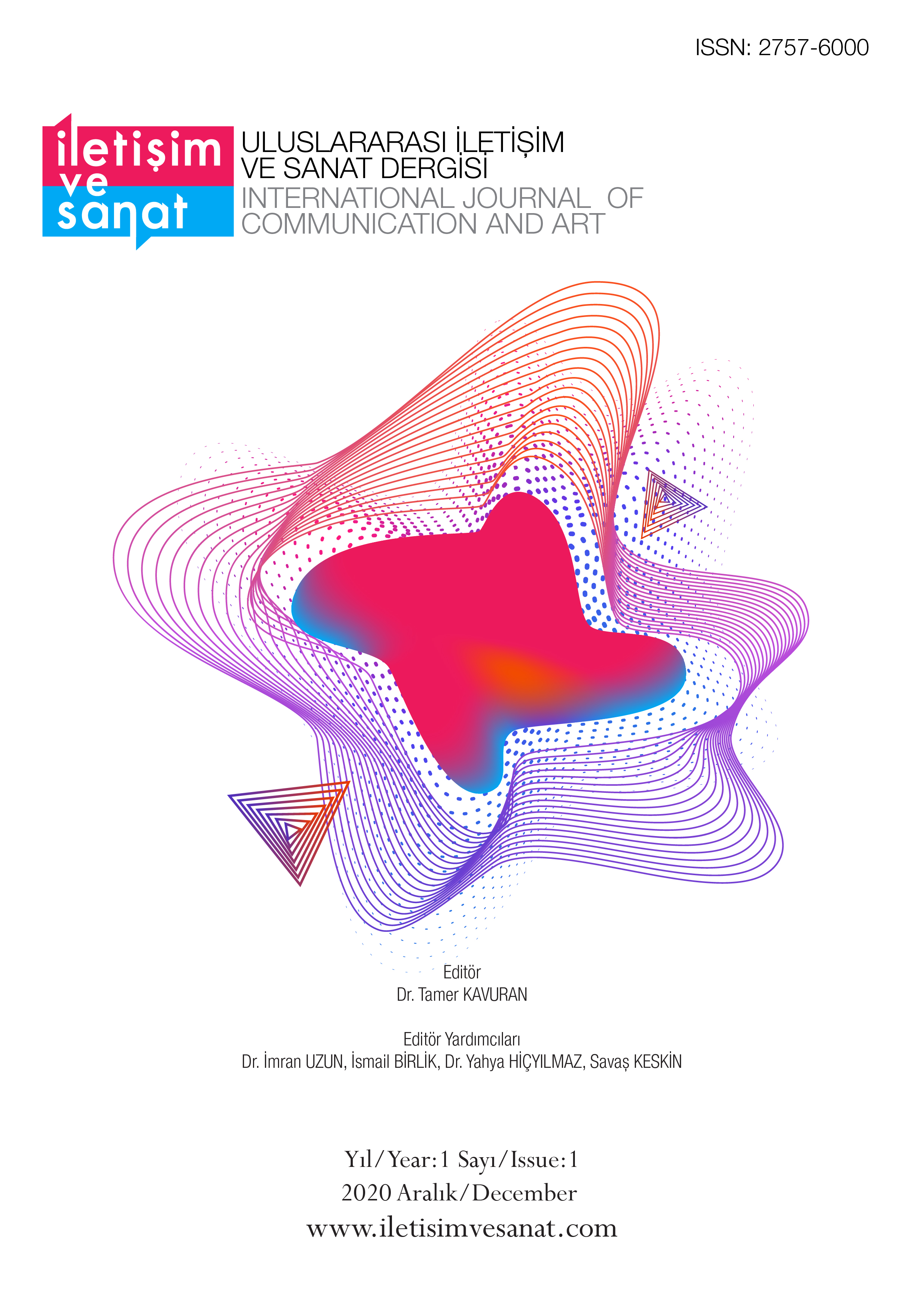Author :
Abstract
Fotoğraf sanatındaki aşkın düşünceyi irdeleyen bu çalışma, soyut kavramların üretilmesinde gerçekliğin fenomenolojik gösterenlerinden faydalanan denemelerden ve bu denemeleri göstergebilimsel yaklaşımla deşifre eden bilimsel uğraşıdan meydana gelmektedir. Fotoğraf sanatının maddeye içkinliğinin tartışıldığı post-modern dönemde, hakikatin nesnel özelliklerini yitirdiği varsayımını konuşan post-truth çağ sanatçıları soyutun maddesel aşkınlık formu olarak izlenimlere hükmettiği önermesini irdelemekte isteklidir. Bu çalışma, empresyonist sanatsal bakışın biçimlendirdiği soyutlama kavrayışını uzun süreli bir pratikte derleyen soyutlama denemeleriyle ilgili alanyazına katkı sunmayı hedeflemektedir. Çalışmanın amacı, klasik natüralist tavırla kavramsal tavrın işbirliğinde yükselen yeni bir fotoğrafik görme biçiminin somut çıktıları üzerinden soyut düşünceyi anlatmak ve göstergelerin taşıdıkları anlamları soyutlayıcı bir müdahale ve yaratıcı eylemle kurmaktır. Bu bağlamda, İmran Uzun fotoğraf antolojisinden 4 fotoğraf birer deneme olarak seçilmiş ve çalışma amaçları doğrultusunda Roland Barthes’in göstergebilimsel yaklaşımına göre çözümlenmiştir. Yüzey, buz, su ve ışık temalarında soyutlanan fotoğrafik göstergelerin taşıdıkları yan anlamları deşifre eden bu yaklaşım, görünenin ardındaki kavramsal ve aşkın gerçeklikle kurulan araçsal ilişkiyi, fotoğrafın konumundan anlamaya çalışmaktadır. Çalışma, fotoğraf üzerine yazılan, çizilen, söylenen ve diğer birçok yolla kayıt altına alınan düşüncelere katkı sunması ve soyut düşüncenin aşkınlığını somutun içkinliğindeki keşiflerle anlatması bakımından önemlidir. Çalışmanın sonuçları, hakikatle kurulan deneysel ilişkilerin belirli bir kavramsal çıkarım üretmedikçe yavan kaldığını, anlam mefhumunun nesnel değil nesneler ötesi fenomenolojik bir tavırla ideal biçime erişeceğini ortaya koymaktadır.
Keywords
Abstract
This study, which examines the transcendental thought in the art of photography, consists of essays utilizing the phenomenological manifestations of reality in the production of abstract concepts and the scientific endeavors that decipher these essays with a semiotic approach. In the post-modern era, when the immanence of the art of photography to matter is discussed, post-truth era artists, who speak of the assumption that truth loses objective features, are eager to examine the proposition that abstract dominates impressions as a form of material transcendence. This study aims to contribute to the literature on abstraction experiments which compiles the concept of abstraction formed by impressionist artistic point of view in a long term practice. The aim of the study is to explain abstract thought through the concrete outputs of a new photographic form of vision rising in cooperation with the classical naturalist attitude and conceptual attitude and to construct the meanings of the indicators with an abstract intervention and creative action. In this context, 48 photographs from Imran Uzun photographic anthology were selected as essays and 16 of them were analyzed according to Roland Barthes' semiotic approach for the purposes of the study. This approach, which decipheres the connotations of photographic indicators abstracted on surface, ice, water and light themes, tries to understand the instrumental relationship established with the conceptual and transcendental reality behind the visible from the position of the photograph. The study is important in that it contributes to the thoughts written, drawn, sung, and recorded in many other ways on photography and tells the transcendence of abstract thought through discoveries in the immanence of the concrete. The results of the study show that the experimental relationships established with the truth remain uninspired unless they produce a specific conceptual inference, and that the notion of meaning will reach the ideal form with a phenomenological but not objective object.
Keywords
- Barthes, R. (2008). Camera Lucida: Fotoğraf Üzerine Düşünceler. Çev. Reha Akçakaya.
- Barthes, R. (2008). Camera Lucida: Fotoğraf Üzerine Düşünceler. Çev. Reha Akçakaya. İstanbul. Altıkırkbeş Yayınları.
- Bonfand, A. (2015) Soyut Sanat. Dost Kitabevi.
- Çelikkan, Ş.G. (2018). Modern ve Postmodern Dönemlerde Soyut Sanat Felfesesi 1. Baskı. İzmir: Mungan Kavram Yayınevi
- Eco, U. (1989). The Open Work. Trans. Anna Concogni. USA. Harvard University Press.Foucault, M. (1994). Kelimeler ve Şeyler. Çev. M. Ali Kılıçbay. Ankara: İmge Kitapevi.
- Gönülal, Ö. (2019). Soyut Resimden Soyut Fotoğrafa…http://aves.akdeniz.edu.tr/YayinGoster.aspx?ID=2039&NO=6 adresinden ulaşıldı. Erişim Tarihi: 22.11.2020.
- Hall, S. (1997). The Work of Representation. Representations. Cultural Representations and Signifying (in). Ed. Stuart Hall. London: Sage Publications. 13-74.
- Hall, S. (1999). İdeolojinin Keşfi: Medya Çalışmalarında Baskı Altında Tutulanın GeriDönüşü. Medya, İktidar, İdeoloji. Der. Mehmet Küçük. Ankara: Bilim ve Sanat Yayınları. 77- 126.
- Hegel, F. (2016). Tinin Görüngübilimi. Çev. Aziz Yardımlı. İstanbul: İdea Yayınevi.
- Kant, İ. (1999). Pratik Aklın Eleştirisi. Çev. Ülker Gökberk v.d. İstanbul: Türkiye Felsefe Kurumu Yayınları.
- Karaman, E. (2017). “Roland Barthes ve Charles Sanders Peırce’ın Göstergebılımsel Yaklaşımlarının Karşılaştırılması”. İstanbul Aydın Üniversitesi Dergisi 34, 25-36.
- Snyder, J. and Allen, Neil W. (1975). “Photography, Vision and Representation”. Chicago Journals. 2 (1), 143-169.
- Tunalı, İ. (1983). Felsefenin Işığında Modern Resim. İstanbul Remzi Kitabevi.
- Wicks, R. (1989). Photography as A Representational Art. British Journal of Aesthetics. 29 (1).Worringer, W. (2017). Soyutlama ve Özdeşleyim. Çev. İsmail Tunalı. İstanbul: Hayalperest Yayınları.
- Worringer, W. (2017). Soyutlama ve Özdeşleyim. Çev. İsmail Tunalı. İstanbul: Hayalperest Y





